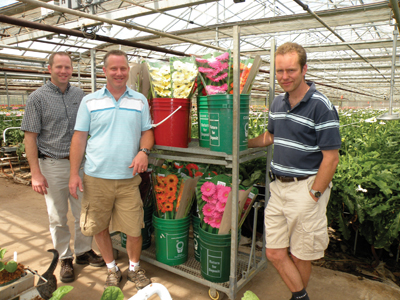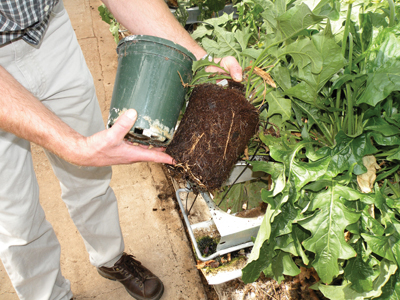
Features
Business
Grower Profiles
Van Geest Bros. reach milestone
September 28, 2009 By Dave Harrison
It’s been especially challenging the past decade or two in the Canadian greenhouse cut flower market. Energy prices are nibbling away at profit margins, and so too are rising South American imports; the new free trade deal with Colombia certainly won’t ease the latter. Consumer preferences on varieties and colours are difficult to anticipate when it comes to crop planning.
It’s been especially challenging the past decade or two in the Canadian greenhouse cut flower market. Energy prices are nibbling away at profit margins, and so too are rising South American imports; the new free trade deal with Colombia certainly won’t ease the latter. Consumer preferences on varieties and colours are difficult to anticipate when it comes to crop planning.

|
| Rob, Bryan and John Van Geest. Advertisement
|
In short, it takes a lot to survive in this industry.
One company that has been more than holding its own over the years is Van Geest Brothers Limited, with greenhouses in Grimsby, the home farm, and in nearby St. Catharines. With 300,000 square feet of production under glass, it’s one of the largest cut flower growing operations in the province.This is a significant milestone year. The company is celebrating its golden anniversary with an open house and barbecue Sept. 26 at its Grimsby location (11 Kerman Ave., just minutes south of the Queen Elizabeth Highway; take the Casablanca exit), from 10 a.m. to 2 p.m.
 |
|
| The coconut growing media is biodegradable |
THIS IS THE SECOND GENERATION OF BROTHERS TO OWN THE COMPANY
The main crop is gerbera, with 180,000 square feet, followed by spray mums and alstroemeria, each with 60,000 square feet. Both standard and mini gerbera are grown.
This is the second generation of “Van Geest Brothers” to own the company. The first generation was represented by Cornelius (Cor) and Adrian Van Geest when they purchased a 50,000-square-foot greenhouse in Grimsby in 1959. (On a historical note, remnants from an earlier greenhouse operation dating back to 1876 – including post footings and boiler equipment – were found on the farm during expansion excavations.)
They began with azaleas, ferns and other potted crops, before adding some cut flowers. They also grew tomatoes each spring for a number of years.
In 1970, Adrian left to set up his own company, Park Avenue Greenhouses.
Cor continued on with the original company, and grew a number of cut flower crops in response to consumer demand, including standard mums, carnations, lisianthus, stocks, and bouvardia, among others. The current crop mix was established at the beginning of this decade.
In 2003, sons John, Bryan and Rob – the second generation of Van Geest brothers – took over controlling interests in the company, with help from siblings Andrea and Colin.
STRONG FAMILY TIES REMAIN WITH THE INDUSTRY
The industry is in their blood. Both their parents grew up in the business. Cor’s family have been growers in the Netherlands since the early 1900s. Four of his five siblings – a sister became a teacher – have continued the tradition. Barbara, their mom, grew up in a family of greenhouse vegetable growers in England.
Their children began helping out as soon as they could, and enjoy being able to work with other family members. John came on board full time in 1986, followed by Bryan (1991), Rob (1994), Andrea (1997) and Colin (1999).
Employees have always been treated like part of the family. That philosophy, no doubt, has been the reason so many staff have been with them for at least a decade or two. A recent retiree had worked for the family for some 35 years. “We’ve always tried to create a family-like atmosphere here at work,” explains Bryan.
The company has grown from a handful of employees in 1959 to its current level of 40.
Van Geest Brothers was among the first Ontario flower growers to build poly greenhouses, to go along with their existing glass houses. However, the poly was eventually replaced with glass. “The problem with poly and cut flowers is the reduced light levels in the winter months,” says Bryan. “You need all the light you can get in the winter.”
The company was one of the first to sign up for the F&V Energy Co-op, now known as AgEnergy Co-operative.
They were one of the first flower growers in Ontario to install computerized environmental controls. There were some potted plant producers already using them, says Bryan, but Van Geest Brothers was certainly among the first cut flower growers to use them.
AN EARLY AUTOMATED BLACKOUT SYSTEM FOR MUMS
They were also among the first cut flower growers in the province to use an automated blackout curtain system for mums.
John noted they were also one of the first greenhouses to grow cut gerbera, beginning in the late 1980s. “It didn’t seem to be much of a market at the time,” he recalls. It’s now one of the most popular cut flowers grown in Ontario. “The interest has certainly grown since then.”
Van Geest Brothers started with 1,500 gerbera plants. They now grow 135,000 at the two locations.
They were among the first cut flower growers to use biological controls for whitefly, he adds, and in particular with gerbera. “We weren’t getting good control with sprays because of resistance, and we knew the future was with biocontrols. It took time to become confident with it.”
Rob agrees. “We pulled the plug a couple of times and had to start all over again, but we stuck with it. We know it works.”
Rob says growers have to adapt to the market. “You have to be flexible and willing to try something new.” Carnations and standard mums used to be major crops for them, “but you have to anticipate the trends and be ready to change.”
NIAGARA AN IDEAL LOCATION FOR GREENHOUSE PRODUCTION
The Niagara region is ideal for greenhouses, Rob says, thanks to the environmental buffering provided by the nearby Niagara Escarpment, which acts as a windbreak, and Lake Ontario, which moderates temperature extremes.
Bryan is following in his dad’s footsteps in volunteering with Flowers Canada Ontario. Cor was president in 1983-84, and was responsible for introducing the popular “Let’s Discuss It” program, in which growers would meet periodically to share information. Bryan currently serves on the board of directors, and is working with its Pick Ontario flower promotion committee.
In the Niagara region, you only have to look at the success of the wine industry to see the benefits of growers working together, says Bryan. Flowers Canada is working to play that same role for the ornamental sector, and to do so needs grower support.
The brothers have no plans to expand at present, and have been optimizing what they already have. They’re continually investing in the greenhouses, particularly from an energy efficiency perspective. “There’s no new square footage going up,” says John, “but we’re working to get the most out of what we have.”
The company was featured in an October 1988 edition of Greenhouse Canada, about two years after it bought the St. Catharines facility.
Interviewed by then editor-in-chief Dave MacLaren, Cor summed up his marketing philosophy. “Freshness and quality is the only way to build a good market.”
It’s proven to be a good recipe for success. Van Geest Brothers flowers are now sold in Ontario, Québec and the Maritimes, and throughout the eastern seaboard and midwest regions in the U.S. They’ve had inquiries from as far south as Miami.
Among sustainability initiatives, and in addition to the IPM program, water is also recirculated. “When making business decisions,” say the brothers, “we look at how this decision will impact the environment, our neighbours and our final customers. We are not just in business to make money. We’re in this business because this is what we enjoy doing. We want to have a clean, safe and happy environment for our employees, and we want to offer the best and longest-lasting cut flowers so our customers will be happy.”
The family’s strong Christian faith has been incorporated into their business philosophy on sustainability initiatives and day-to-day management practices. “The only way the company has been in business for 50 years,” say the brothers, “is because of the grace of God.”
Print this page